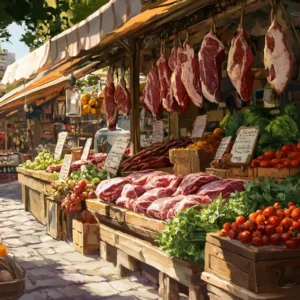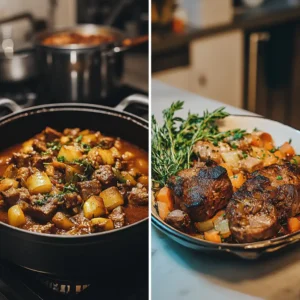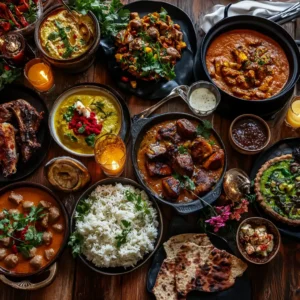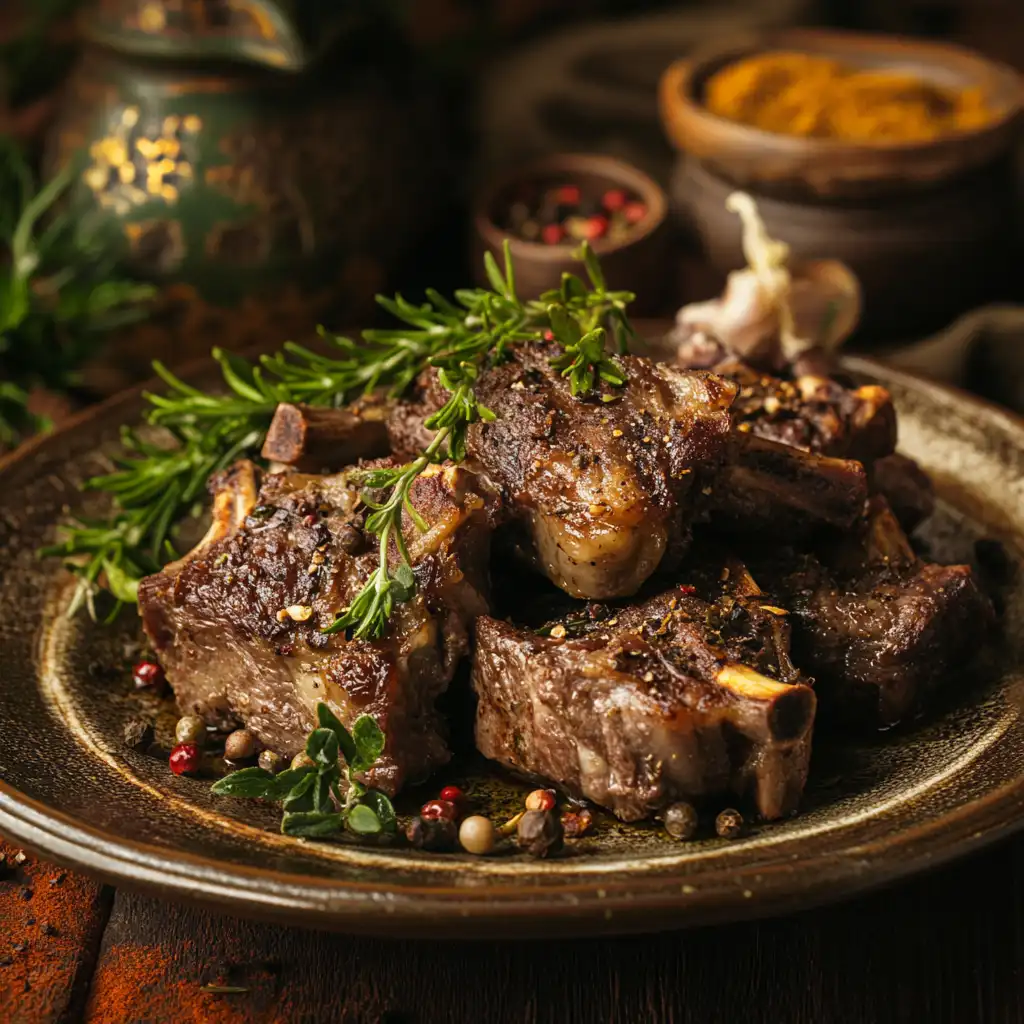Goat meat is one of the most widely consumed proteins globally, yet its terminology often varies depending on the region, culture, and the age of the animal. Understanding what goat meat is called can help demystify its role in global cuisines and make it easier to source and prepare.
In many parts of the world, it carries specific names that reflect its culinary and cultural significance. These names, such as chevon, cabrito, and capretto, often indicate the age of the goat and the preferred cooking methods. While this meat is a dietary staple in regions like Africa, Asia, and the Middle East, it is less common in Western countries, where consumers may be less familiar with its terminology.
This article explores the various names for goat meat, the distinctions between terms like chevon and cabrito, and the cultural importance of this versatile protein. By the end, you’ll have a clearer understanding of goat meat’s terminology and how it varies across the world.
Table of Contents
Names for Goat Meat by Region
The name for this meat often depends on the region, the age of the animal, and the culinary context. Different terms are used worldwide, reflecting local languages, traditions, and preferences. Here are some of the most common names and their origins.

Chevon, Cabrito, and Capretto
- Chevon:
The term “chevon” originates from the French word chèvre, meaning goat. It generally refers to the meat of an adult goat and is used primarily in Western culinary contexts. Chevon has a rich, slightly gamey flavor and works well in slow-cooked dishes like stews or roasts. - Cabrito:
“Cabrito,” a Spanish and Portuguese term, refers to the meat of a young goat, usually slaughtered within the first few weeks of birth. The meat is tender and mild, making it ideal for grilling or roasting. Cabrito is especially popular in Latin American countries and regions with Iberian influences. - Capretto:
Derived from the Italian word capra (goat), “capretto” refers to the meat of a young goat, similar to cabrito. Italians often prepare capretto during festive occasions, roasting it with herbs and olive oil for a succulent and flavorful dish.
Mutton and Its Goat Meat Association
The term “mutton” traditionally refers to the meat of an adult sheep. However, in some countries, particularly in South Asia and the Caribbean, “mutton” also applies to meat. This dual usage can create confusion, especially for those unfamiliar with regional terminology.
In Indian and Pakistani cuisine, for example, dishes labeled as “mutton curry” or “mutton biryani” are often made with goat meat rather than sheep meat. Similarly, Caribbean dishes like mutton stew may feature goat as the primary protein.
Regional Names for Goat Meat
- Africa: In many African countries, goat meat is simply referred to as “goat” or by local names in native languages. It is a staple protein, used in stews, soups, and grilled preparations.
- Middle East: Goat often appears as “mishwi” (roasted goat) or similar terms, depending on the dish and preparation method.
- Asia: In India, Pakistan, and Bangladesh, this meat is commonly called “mutton” in everyday language. In Indonesia, “kambing” refers to goat.
- Caribbean: Goat cuts is a central ingredient in dishes like curry goat, where it is often referred to simply as “mutton” in some areas.
- Mexico and Latin America: Cabrito is the most popular term for young goat meat, especially in roasted dishes.
Understanding the Differences Between Terms
The names for goat meat, such as chevon, cabrito, and capretto, often depend on the goat’s age and culinary context. Understanding these terms can help clarify how the meat is used in various cuisines and why the distinctions matter.

Chevon vs. Cabrito vs. Capretto
- Chevon:
Chevon refers to the meat of an adult goat, typically over one year old. The flavor is rich and slightly gamey, with a firmer texture compared to younger goat meat. This term is most common in Western culinary contexts, where the meat is often slow-cooked to enhance tenderness. - Cabrito:
Cabrito comes from young goats that are milk-fed and under three months old. The meat is tender, mild, and delicate in flavor, making it ideal for grilling or roasting. Latin American cuisines, particularly Mexican and Brazilian, celebrate cabrito in dishes like spit-roasted goat. - Capretto:
Capretto, similar to cabrito, refers to young goat meat in Italian cuisine. Italians traditionally serve capretto during festive occasions like Easter. The preparation often involves roasting or braising with herbs, olive oil, and garlic for a savory, tender result.
How Age Influences Name and Flavor
The age of the goat significantly impacts the meat’s flavor, texture, and the name it is given:
- Young Goats (Cabrito or Capretto): These goats produce tender meat with a mild flavor, ideal for quick cooking methods like grilling, frying, or roasting.
- Adult Goats (Chevon): Older goats provide meat with a deeper, gamey flavor and firmer texture. Slow-cooking methods, such as braising or stewing, help make the meat tender and flavorful.
- Milk-Fed Goats: Very young goats, still on a milk diet, yield the most tender and mild-tasting meat, commonly used for special occasions.
Mutton and Its Dual Meaning
The term “mutton” often leads to confusion because of its dual meaning. In many Western countries, mutton strictly refers to the meat of an older sheep. However, in South Asia, the Caribbean, and parts of the Middle East, “mutton” often refers to goat meat.
This usage stems from colonial influences, where local languages adopted the term to describe the most commonly consumed red meat. For example:
- India and Pakistan: Recipes for mutton curry or mutton biryani typically feature goat meat.
- Caribbean: Dishes like “mutton stew” often use goat meat as the primary protein.
Understanding these regional nuances can help avoid confusion when encountering recipes or menus using the term “mutton.”
Understanding the Differences Between Terms
The various terms for goat meat—such as chevon, cabrito, and capretto—carry specific meanings based on the age of the animal and the culinary traditions of different regions. Understanding these distinctions helps clarify how this meat is categorized and used.
Chevon vs. Cabrito vs. Capretto
- Chevon:
Chevon refers to the meat of a mature goat, typically over six months old. It has a robust flavor and firmer texture, making it ideal for slow-cooked dishes like braises or stews. Its stronger taste works well with bold spices and marinades. - Cabrito:
Cabrito comes from very young goats, typically under eight weeks old. The meat is tender, mild, and less fatty, making it perfect for grilling or roasting. Cabrito is prized in Mexican and Latin American cuisine, where it often features in celebratory dishes. - Capretto:
Similar to cabrito, capretto refers to meat from a young goat, particularly in Italian cuisine. Capretto is often roasted whole or prepared with herbs and olive oil, resulting in a dish with delicate flavor and tender texture.
How Age Influences Name and Flavor
The age of a goat greatly impacts its meat’s flavor, tenderness, and culinary application:
- Young Goats (Cabrito/Capretto): These animals have tender, mild-flavored meat that is ideal for quick-cooking methods like grilling or roasting.
- Mature Goats (Chevon): Older goats develop a richer, gamier taste and firmer texture. This meat is better suited for slow-cooked recipes, such as curries, stews, or braised dishes.
Knowing the goat’s age can help you choose the right cut and cooking method to match your recipe.
Mutton and Its Dual Meaning
In some regions, “mutton” refers to both goat and sheep meat, which can cause confusion:
- South Asia: In countries like India and Pakistan, “mutton” is commonly used as a blanket term for goat meat, even though it traditionally refers to adult sheep in Western countries.
- Caribbean: Similarly, Caribbean cuisine often uses “mutton” to describe meat in popular dishes like mutton curry or stew.
This dual meaning underscores the importance of understanding regional context when encountering the term “mutton.”
Why Is Goat Meat Called Chevon?
The term “chevon” is one of the most commonly used names for goat, particularly in Western culinary contexts. Its origins and adoption highlight the influence of language and tradition in food terminology.
The French Influence on Goat Meat Terminology
“Chevon” originates from the French word chèvre, which means goat. The suffix “-on” aligns with the naming convention for meats in French culinary traditions, such as bœuf (beef) and porc (pork). The adoption of this term likely occurred as a way to standardize and elevate the presentation of goat meat in Western menus, where French culinary terms often hold prestige.
Unlike terms like “cabrito” or “capretto,” which emphasize the youth of the goat, “chevon” applies to the meat of mature goats. This distinction makes it a broader term that encompasses a wider variety of culinary applications.
Chevon in Global Culinary Contexts
Although “chevon” is not universally recognized, it has gained traction in Western countries as a formal name for this meat. It helps distinguish goat meat from other proteins while lending it a unique identity:
- In the U.S. and Europe: “Chevon” appears more frequently on menus, particularly in fine dining restaurants that serve goat meat as part of gourmet dishes.
- In Culinary Education: Institutions and professionals use “chevon” to teach about goat meat’s preparation and uses.
- Market Appeal: The term makes this meat sound refined, helping it appeal to consumers who might otherwise view it as an unfamiliar or niche protein.
While the name “chevon” has gained prominence, its adoption remains limited compared to the global usage of terms like “cabrito” or “mutton” for this meat.
Why Is Goat Meat Called Chevon?
The term “chevon” is commonly used to describe goat meat, especially in Western culinary contexts. Its origin lies in French, where the word chèvre means goat. Over time, “chevon” became an English adaptation to label this flavorful option in a way that aligns with naming conventions for other meats, such as beef (from cattle) and pork (from pigs).
The French Influence on Goat Meat Terminology
During the Norman Conquest of England in the 11th century, the French language heavily influenced English culinary terms. For example:
- Boeuf (Beef): Refers to the meat of cattle.
- Porc (Pork): Refers to the meat of pigs.
- Chèvre (Chevon): Similarly, this French word for goat inspired the adoption of “chevon” to refer to goat.
Although not as widely used as beef or pork, the term “chevon” provides a formal and standardized way to describe goat meat in culinary contexts.
Chevon in Global Culinary Contexts
While “chevon” remains less familiar to many English-speaking consumers, it is increasingly used in fine dining and global gastronomy to refer to capretto. Countries like France, the United States, and parts of Europe use the term when marketing goat meat as a premium product.
Additionally, the adoption of “chevon” helps distinguish the meat from “mutton,” which can refer to both goat and sheep meat in certain regions. This clarity is especially useful for chefs and food enthusiasts exploring diverse cuisines.
Cultural Significance of Goat Meat
Goat meat holds a prominent place in global cuisines and traditions. Beyond being a dietary staple, it often symbolizes abundance, hospitality, and celebration in many cultures. Its cultural significance varies by region but remains deeply rooted in culinary practices and rituals.

Goat Meat in Global Cuisines
- Africa:
In many African countries, goat meat is a central protein source, prepared in stews, grilled dishes, and soups. It is often seasoned with bold spices and herbs, reflecting the diverse culinary traditions of the continent. - Asia:
Countries like India, Pakistan, and Indonesia prominently feature Capretto in dishes such as biryani, curries, and satay. In these cuisines, goat meat is celebrated for its rich flavor and adaptability to spiced preparations. - Middle East:
Roasted goat is a highlight of Middle Eastern cuisine, served during festive occasions and family gatherings. Dishes like goat kabobs and goat-stuffed pita showcase the region’s love for this flavorful meat. - Caribbean:
In the Caribbean, this meat is a favorite ingredient in dishes like curry goat, often served with rice and beans. It is also a key part of celebratory meals during festivals and holidays.
Festive and Ceremonial Uses
Goat meat is more than just a meal in many cultures; it plays a significant role in religious and ceremonial events:
- Eid Celebrations: During Islamic holidays such as Eid al-Adha, families often sacrifice goats and distribute the meat to the community as an act of charity and gratitude.
- Weddings and Feasts: In countries like Nigeria and India, cabrito features prominently in wedding banquets and festive feasts, symbolizing prosperity and joy.
- Harvest Festivals: In parts of Latin America and Europe, goat cuts is associated with harvest celebrations, where it is prepared in elaborate dishes shared among family and friends.
The Symbolism of Goat Meat in Traditions
In addition to its culinary significance, goat meat carries symbolic meaning in many cultures:
- Hospitality: Serving this meat is often considered a sign of respect and generosity, particularly when hosting guests or celebrating milestones.
- Community Bonding: Preparing and sharing cabrito during festivals and holidays strengthens social ties and fosters communal harmony.
- Sacrifice and Rituals: In some traditions, goats are offered as sacrifices to honor deities or mark significant life events, reinforcing their cultural and spiritual importance.
FAQs
To clarify common questions about the names and uses of chevon, here are answers to frequently asked queries:
Is goat meat called mutton?
Yes, in some regions, particularly South Asia and the Caribbean, people refer to goat meat as “mutton.” However, in Western countries, “mutton” typically refers to the meat of adult sheep. This dual meaning can cause confusion, so it’s essential to consider the regional context.
What is the difference between chevon and cabrito?
Chevon refers to meat from a mature goat, usually older than six months, and has a robust flavor and firmer texture. Cabrito, on the other hand, comes from very young goats, typically under eight weeks old, and is tender with a milder taste.
How do I know the quality of goat meat?
High-quality goat cuts should have a fresh, mild smell and a firm, pinkish-red color. Avoid meat that looks gray, has a slimy texture, or emits a strong, unpleasant odor. If buying frozen, ensure the packaging is intact with no signs of freezer burn.
Does the name of goat meat affect how it’s cooked?
Yes, the name often indicates the goat’s age and influences cooking methods. For example:
- Chevon (adult goat): Best for slow-cooking methods like braising or stewing to tenderize the meat.
- Cabrito or Capretto (young goat): Suitable for quick-cooking methods like grilling or roasting due to its tender texture.
Where can I buy goat meat labeled as chevon or cabrito?
Specialty butcher shops, ethnic markets, and online meat retailers are your best options. Some small farms and farm-to-table programs also offer goat meat, often labeled as chevon, cabrito, or capretto, depending on the region.
Conclusion
Goat meat, recognized by names like chevon, cabrito, and capretto, showcases its cultural and culinary importance around the globe. These terms not only reflect the age of the goat but also its role in different cooking methods, emphasizing the meat’s diversity and appeal. In some regions, people refer to it as “mutton,” underscoring the need to understand these distinctions for easier sourcing and preparation.
Whether slow-cooked as chevon, roasted as cabrito, or featured in festive dishes as capretto, this protein delivers a rich flavor that complements bold spices and a variety of cuisines. Its widespread use in traditional celebrations and everyday meals highlights its enduring popularity across cultures.
By familiarizing yourself with the different names for chevon and learning how to prepare it, you can fully embrace this nutrient-rich and versatile option. Whether you’re enjoying it in a stew, curry, or grilled dish, goat meat remains a delicious and valued addition to kitchens around the world.

